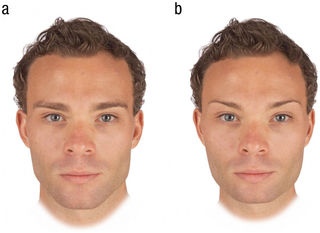Hormones
Do Hormones Change Women’s Taste In Men?
New work challenges the idea that hormones influence women’s mate preferences.
Posted March 4, 2019
Researchers have long argued that masculine physical characteristics in men—traits like a strong jaw, a heavy brow, or broad shoulders—indicate that the man is not only healthy, but likely to father particularly healthy kids. By contrast, feminine physical characteristics in men—traits like a small jaw, larger eyes, or slighter build—are thought to indicate that the man is a caring, sharing person. The evidence for these claims is weak (at best) but they remain strong assumptions in much of the human mate preference research.

Because you might expect women’s mating strategies to be optimized to get the benefits of both healthiness and caringness from their partners, researchers proposed the Dual Mating Strategy hypothesis. This hypothesis would allow women to have this cake and eat it.

The Dual Mating Strategy hypothesis proposes that women will benefit from forming long-term relationships with caring sharing men. These men will be willing to invest time and effort in the relationship and family. However, the Dual Mating Strategy hypothesis also proposes that women will benefit from having healthy offspring by mating with masculine men during the ovulatory phase of the menstrual cycle, when fertility is highest. In other words, the Dual Mating Strategy hypothesis proposes women can maximize the benefits of their mate choices by forming long-term relationships with caring, feminine men to raise the offspring of healthy, masculine men.
This is clearly a controversial idea, not least because it specifically implicates cuckoldry in women’s mating behavior. But is there evidence for the Dual Mating Strategy hypothesis? This is where it all gets a more complicated.

Early research on the topic generally supported the idea. For example, a classic study published in the prestigious journal Nature found that women showed stronger preferences for male faces with masculine shapes when they were ovulating than when they were not. Some of my own work seemed to replicate this original finding. Other research suggested that women are more interested in extra-pair sex when ovulating than at other points in the menstrual cycle. One study found that women showed weaker preferences for masculine men after they started using the oral contraceptive pill. This effect was attributed to the pill preventing ovulation from occurring. Together, results like these seemed to support the Dual Mating Strategy Hypothesis
While these studies supported the Dual Mating Strategy Hypothesis, recent criticism of the methods used in these studies has been loud and extensive. For example, analyses of this literature show clear publication bias. All things being equal, significant results are more likely to be published than null results, giving a biased view of how reliable published results are. The majority of these studies are also underpowered. In other words, they did not test enough women often enough to draw firm conclusions about the claimed effects. These observations led researchers to reexamine these older findings.

Recent work that has addressed these methodological problems paints a very different picture about the Dual Mating Strategy hypothesis. Large-scale studies have found little evidence that women’s preferences for masculine men increase at ovulation or are tied to changes in sex hormones over the menstrual cycle. Women's preferences for masculine bodies and masculine voices also don't appear to increase at ovulation. Women’s extra-pair desire does increase at ovulation, but recent research suggests this increase is similar to what is also seen for in-pair desire (i.e., desire for sex with their romantic partner). This pattern of results suggests women’s sexual desire in general increases at ovulation, not that they suddenly become more open to extra-pair sex specifically (not all studies have found this, however). The finding that starting using the oral contraceptive pill decreases masculinity preferences has also not replicated in larger studies. Although these results suggest that hormones don't necessarily change women's taste in men, at least two recent studies suggest that straight women may be more attracted to men in general at ovulation.
Why the sudden change in the type of results reported in this literature? One possibility is that journals are becoming more open to publishing null results and non-replications. Another possibility is that researchers now have developed a greater understanding of the types of questionable practices that can lead to these false positives appearing in the literature. Regardless of the reasons why, it would appear that hormones don’t change women’s taste in men after all.


